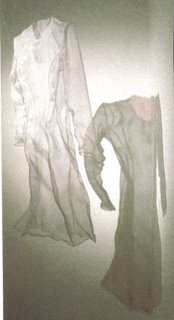The Uncanny Room - Contemporary Art at Pitshanger Manor.

Ralph Ball,'T.4.4' 1997

Emma Woffenden, 'Contract' 1999

Caroline Broadhead, 'Ready to Tear', scorched silk dress and shadow in pencil. 1998.
In 2002, an exhibition entitiled The Uncanny Room was held at the Gallery, Pitshanger Manor, London. The works shown above are a small selection of the uncanny art objects installed into the gallery rooms of this former manor house. Writting about his arts practice, Ralph Ball states,'Rhetorically the work deliberately disregards the discrete categories of art, craft and design. It attempts to explore the expressive possibilities of the space in-between'. Describing his recent work Ball calls it,'strangely strange, oddly normal objects in a domestic environment'. Characteristically his objects retain familiar references but are rendered uncanny as they confront our assumptions about designed objects and the culture that surrounds them.
Emma Woffenden's 'Contract' is suggestive of a wall mounted hunting trophy and of arms waving through walls as in Jean Cocteau's Orphee` - on the one hand death, on the other some primordal life form. Such ambiguities add to the narrative possibilities of a work and amplify its uncanny content.
In Caroline Broadheads work an uncanny effect is often produced through the co-existence of elements; a tulle garment may be barely perceptable, yet its shadow painted on a wall is accentuated, '...to give emphasis to the hidden, non-existent and immaterial'.
In the accompanying exhibition catalogue there is an excellent essay on the uncanny called Magical Properties written by Esther Leslie. Discussing the uncanny, leslie writes,'Uncanny moments rupture the normal flow of events, disturbing participants' sense of things, corrupting rational categories of understanding. Such interruption of the quotidian, this breakage of continuity, is an attack on time as it is usually lived.' Also,'always at work in the uncanny is an ambiguous melding of fact and fiction. The uncanny can work on us whether we are subjected to it through direct experience or through fictional representations; in either case it relies on smudging the experiencer's sense of what is real and what is imagined. Uncertainty seeds the uncanny'. This is a crucial point in my own observations of the uncertainty of our times and of the uncanny art that is produced from our anxious, fearful culture.

0 Comments:
Post a Comment
<< Home